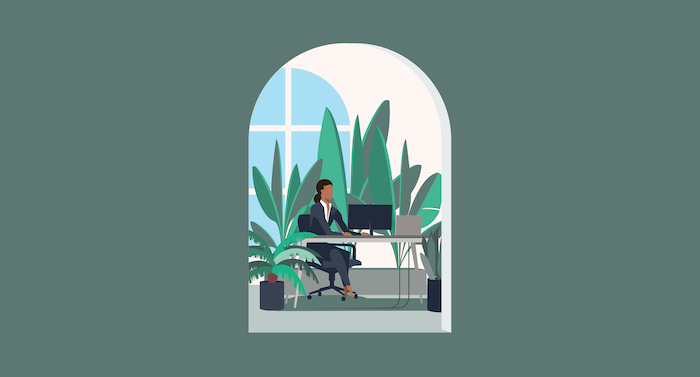
“The pandemic really challenged us, stressed us, tested us, surprised us in different ways, you know, it did all these kinds of different things for different people. I believe there's tremendous learnings to be had from studying user behaviors and making relationships in the many ways that people perform, conduct themselves, interact, and engage with each other, both in person and virtually."
– Mark Lo Bue, Workplace Strategy Director at Avison Young
In this episode
What the office means to us is rapidly evolving. Driven by the flexibility and balance pandemic-driven remote work afforded us, we are starting to question en masse – what is the role of the office in our lives? What part does it need to play in our work?
As we re-enter our long-forgotten offices, it’s time to consider what they offer us.
Are they built with inclusivity in mind? Are we welcomed by plant life and energizing human-centered design, or are we finding ourselves in the same old cookie cutter, freezing, and cramped office space with bad coffee and bright fluorescent glow?
What do we really need, and what should we consider as employees call for changes to the workplace like we’ve never seen before?
Host Mariam Sobh discusses office design – what it’s been to us historically, what it is today, and where we could see it moving for us tomorrow – with guests Ryan Anderson, Vice President of Global Research and Insights at MillerKnoll, and Mark Lo Bue, Workplace Strategy Director at Avison Young, in this episode of Changing Places.
Highlights
- 2:32 Ryan Anderson shares the evolution of offices, and how they evolved through different design movements.
- 20:05 Mark Lo Bue discusses elements of office environments, what elements need to be considered when designing and supporting office spaces.
- 22:17 Ryan Anderson projects where we will be in the world of office design 5 years from now, and how design of our office spaces has changed compared to the mid-late 2010s.
Click here to expand transcript
Streeter #1 [00:03] So thinking about office spaces and greenery, I feel kind of spoiled because Google, that's currently my employer, just opened a really nice office, One Maritime Plaza, and the aesthetics are beautiful. I don't know if you've been, but just when you enter One Maritime Plaza, there’s like indoor greenery, just beautiful green space. I took a video call from there, and my family was like are you in a rainforest? Are you out hiking? So that's how real it is. And these are like live plants. So it's really thrilling. It's, it's just got elevator right now or escalators. But it's a cool place to hang out just because of the environment they've created. So I love it.
Mariam Sobh [00:42] The office, we all have a vision of it, whether we're thinking about it in the context of the British sitcom or the place you go to Monday through Friday. Or maybe you're still working at home wearing your favourite blouse and pyjama bottoms all day long. No matter what kind of office you call home, what the office means to us is rapidly evolving. Consider this, according to Flex Jobs, 65% of those working from home during the pandemic would prefer to stay at home. A survey from ADP notes that two-thirds of office workers would look for another job if their current job asked them to return to the office. This makes me curious, if office workers are reluctant to return to their offices en masse, why? What are we getting in our offices? I'm sure we've all experienced overly lit, freezing offices with one coffeemaker and a copier which doesn't quite do its job. And yet there is motion afoot to change all of that, to bring nature, light, inclusion and accessibility into the offices of today, tomorrow and beyond. I’m Mariam Sobh, throughout this episode, we'll hear from Mark Lo Bue, a corporate design veteran with over 19 years experience, about his thoughts, opinions and ideas about the current state of office design and its future. But first, I want to dive into how our offices became the way they are with Ryan Anderson, Vice President of Global Research & Insights, at Miller Knoll. Ryan works in the area of office design and is an expert on where our offices will take us tomorrow. Ryan Anderson, welcome to Changing Places. I want to know how we got to the offices of today.
Mariam Sobh [02:31] Sure, yeah. Well, it's been a long journey. I mean, to give you like a quick overview, offices started the late 1800s. They were usually associated with some sort of manufacturing environment, and the rows of desks were basically built on Taylorist principles. It was almost like a factory for paperwork. And it continued to evolve. There was a brief time after World War Two where things got kind of interesting. In a movement known as Bürolandschaft, which is German for office landscape, there was this idea in Europe, postwar Europe, that maybe the office could become more like a cityscape, you know, a landscape of places where you could move around and have a great variety of activities. But that, unfortunately, basically got put on the shelf with the rise of desktop computing. When desktop computers and desktop phones became the dominant technologies for what really was office work, it tethered people to very specific locations within the office; the furniture essentially became a highway for power and data distribution. And a lot of our assumptions about work, even the notion of office work. developed during those years that work had to be done in an office. You did your individual work in one place assigned to you. If you wanted to go work with other people, you'd go to a conference room, and collaboration was synchronous, it was always happening at the same time. Even how we think about supervisory practices that presenteeism like if you weren't there, you clearly weren't being productive. We had decades worth of ideas about how work is done that developed during those years. By the way, the work has been changing drastically for the last 20 years, but the assumptions about work remained and that's why offices essentially have been a pretty consistent thing until very recently.
Mariam Sobh [04:19] I do want to dig into what we're seeing now in the world of office design from biophilia, the human tendency to connect with other forms of life in nature, and also inclusivity and beyond, but we'll be back after this tour of Second Homes’ Los Angeles office.
Second Home Walking Tour [04:34] So this is the main building Second Home. This building was built in 1964 by the architect Paul Williams for the assistance League of Southern California. Paul Williams is a really renowned architect, especially here in Los Angeles. He was known as the architect of the stars. He did a lot of private residential projects for celebrities like Lucille Ball and Frank Sinatra. He did a lot of homes in Palm Springs as well. But this was not a residential property. Obviously, it was built for a social good company, the Assistance League of Southern California. When we got this property, we restored the facade of the building. We did rehab the inside of the building; we brought in a lot of natural light. And we sort of opened everything up by having rooms made out of glass. Upstairs, every single office has a window, whether it goes into the courtyard or to the outside of the building. Also, we provide a gigantic roof deck upstairs, we added that roof deck, and that looks out into the 6500 plants that are outside. So these are our indoor offices, they are in the main building, we have 25 of them up here. They're all different shapes and sizes. They kind of connect like a honeycomb almost. As you can see, there's no curtains, there's glass that goes from the waist up, and then we have carpeting that goes halfway up, that really helps us sound. But even if all the lights went out appear, you'd still have plenty of natural light to work.
Mariam Sobh [05:58] Stay tuned for the next part. And just a reminder, Changing Places is a podcast brought to you by Avison Young that continues to explore and question our complex relationship with the built world around us. I'm your host, Mariam Sobh. I hope you're liking the show so far. If so, please share Changing Places with your friends. Before we get back to my conversation with Ryan Anderson, let's hear what Mark Lo Bue thinks about the current state of office design.
Mark Lo Bue [06:27] I think if we think about the current state of the office design, it's changing, and I believe it will continue to change and evolve going forward. The pandemic really challenged us, stressed us, tested us and surprised us in different ways. You know, we did all these kinds of different things for different people. I believe there's tremendous learnings to be had from studying user behaviours and making relationships in many ways that people perform, conduct themselves, interact, and engage with each other, both in person and virtually. So it's a very interesting time as workplace strategists, as designers, as you know, kind of educators in the design industry to help understand what they can look like for organizations.
Mariam Sobh [07:10] Now, let's go back to San Francisco to hear what people think about changes to the office.
Streeter #2 [07:15] My ideal workspace would be an open floor plan with spaces that you can go for quiet, but generally, a lot of the work happens in collaboration with workers, lots of different types of workers, I guess, because it can get mundane or difficult when you only have kind of one perspective.
Streeter #3 [07:37] Yes, I do expect greenery in office spaces because it levels off the working atmosphere. And back in Mumbai in our own office, we do have, you know, an absurdly large amount of plants, which really helps in employee engagement as well as making a lot of fun workplaces and making it a really a place where people would like to work and would definitely, let's look forward to coming.
Mariam Sobh [08:09] Back to my conversation with Ryan Anderson, Vice President of Global Research and insights at Miller Knoll. Ryan, as we come out of the other side of the pandemic and people go back to the office, what kind of designs or changes to the physical space will some workers see or experience in the next year or so?
Ryan Anderson [08:27] I think we've been on a trajectory that offices are becoming what the employees want them to be versus what their employers necessarily may have thought that they needed to be. Because even for those organizations that still have an office-first culture, they realize that the only way to get a good return on their real estate investments is to make sure that these spaces are adding value. And employees are becoming more purposeful about sharing the experiences they expect but also the qualities they expect. So when it comes to experiences, there's a lot of things that are difficult to achieve while working remotely. Not that people can't be successful fully remote. But if we think about as an example, being able to interact with your extended networks and see people who you probably don't have a reason to be on a call with — that’s an important part of feeling like you're part of something bigger. It's an important part of being able to connect what one team is doing with other teams so that community socialization for sure, just as a means of connectivity, is a high priority. Likewise, higher quality time with immediate teammates, like you can do a lot in a video call or using chat, but if you want to hang out for a few hours, ask stupid questions, get some tacit learning, it requires something more immersive and far less formal than a meeting. So employees are looking for those kinds of quality times with their teams. They're also looking by the way for places where they can be assured some ability to focus and concentrate. We've seen 58% of the 26,000 people that have used Herman Miller's work from home tool say they struggle with focus productivity at home. Not always, but there's the dog, kids, delivery people, whatever. And so, in terms of the experiences, it's almost like employees want to be able to show up, be social, see some people they haven't seen, spend some quality time with their team and then get away from everyone for a few hours, if they've got that spreadsheet that they need to focus on for, for half a day. None of this, by the way, is served well by just a sea of desks and conference rooms, we need different types of spaces to support these. But there's, also, I think, a shift in the qualities they're looking for. You mentioned biophilic design a while back. Biophilia is really the ways that indoor environments can mimic or, in some cases, at least, you know, kind of connect to our outdoor habitats. And it speaks to a desire for people to go into spaces that feel healthier, that have a higher degree of comfort, not just physical comfort, but emotional and cognitive. And so I also think that, by the way, during the pandemic, the outdoors was one of the only safe spaces for a lot of people. And so now, coming into an office that seems brighter, that seems like there's more greenery that they're assured to have higher quality indoor air is really appealing, as is any sort of move towards creating more inclusive environments, which is a big and kind of complicated topic. But there are ways of designing space so that you don't see your typical user as typical. You begin to take a look at the breadth of needs and create spaces that, whether it's really clear or whether it's more intuitive, the employees know is designed more for them, like the space exists to serve them, rather than a place where they're just expected to show up. So some, some really serious evolution taking place right now, which I couldn't be more enthused about. Because even for those organizations that might want to shrink up their portfolio a little bit or do some different things — if the environment served the employees well, it's a win-win for everyone.
Mariam Sobh [12:03] You mentioned Biophilia bringing nature into the office. It seems to be kind of a trend that we're seeing second home, and Lisbon, London, and Los Angeles make it a driving part of their office design. Do you think this is a trend that's here to stay or something only a few landlords or owners will take time to really invest in?
Ryan Anderson [12:22] I think it's something that we'll see grow in the future. And I should note that there's a couple of couple different approaches to biophilic design. But if we are talking about qualities, like better lighting, better air quality, larger amounts of greenery, then yeah, I think that's been happening. And you do see this blurring of the outdoors and indoors in really wonderful ways. I should also note that I think we'll see more outdoor work. There's no reason why people can't spend a really meaningful part of their workday on an outdoor terrace that has comfortable furniture and Wi-Fi and breathe fresh air. The one thing I might add in thinking about your question, is that I think a lot of building managers, facility managers, and property owners learned in the pandemic that because COVID was primarily spread through shared air rather than shared surfaces, they pivoted from lots of disinfectants and Purell to, can we measure the CO2 levels in our space? Do we have good air filtration? Do we have a good air exchange? That set the whole topic of healthy buildings kind of on fire in a good way, and I think it's something that hopefully we'll continue to talk about for years to come and not just associate it with public health crisis. Speaking of biophilia, here's our tour of Second Homes’ Los Angeles office.
Second Home Tour [13:42] A key element of all of our designs is Biophilia. And, you know, the idea behind that is that we, as humans are, we evolved in nature and our connection to nature is inherent to our productivity and our creativity. And so, you know, we design all of our spaces to kind of weave nature into the workspace because we believe that that's where people are able to be their most comfortable, their most creative, and solve problems. And so that's, that's a huge part of all of our designs everywhere you go. And in London, our designs are, you know, we bring the nature inside in LA, we were fortunate enough to be in a climate where we're able to bring the office outdoors. And so this is kind of this campus is the first of its kind for us where we have such an extensive outdoor footprint.
Mariam Sobh [14:35] If we think about inclusion within Office design moving forward, Ryan, what does that mean and look like to an employee? Is it just private offices or private phone booths? Is it bigger than that?
Ryan Anderson [14:47] Yeah, it's bigger than that inclusive design at its core, says, We're not going to focus on any particular user group. We're going to try to understand the breadth of these users as broadly as possible, and then when we go to design a space, we're going to kind of beat up the design to say, does it really work for everyone. And this could be true of a lobby, a conference room, a workstation just about anywhere; I will tell you that we have been exploring for at least nine or ten years now a pretty broad range of user groups. As an example, we did a webinar here just last year on the needs of women in menopausal age; the Ministry of Labor in the UK, as an example, has taken a strong interest in understanding the challenges that women and menopause face in the workplace. It's not just thermal discomfort; it's brain fog, etc. And there's mounting data to show that women in the prime of their careers are leaving the workforce. So the temptation here is to then focus on one group, but the ideal is to say, no, let's look at this group's needs relative to everyone else. Let's say that we wanted to have a quiet, contemplative space somewhere on the floor of an office building. If we think about the design of it, for somebody who is on the neurodiversion spectrum, great, we can serve her or him. If we think about that woman of menopausal age we can, we can help her. Think about a person of colour who may be dealing with code-switching or microaggressions, we’re going to provide a respite for that person. Or maybe it's somebody with an anxiety disorder or somebody who's having a lousy day, the goal is if you're going to design a room like that, look at the broadest array of needs possible, maybe you'd say, hey, if we add a lock, and we add a fridge, now that room becomes a great place for a new mom who's nursing, the more we do that, the more the employees will ultimately realize that this space has been informed by their needs. And if we really push the boundaries of it, the design process should be participative. We should be engaging employee resource groups. We should be engaging a broad array of users to say, tell us any real or perceived reasons why you might not want to work here or feel comfortable working here. The more we tackle those, the more inclusive we can get.
Streeter #4 [17:02] The idea of putting in more accommodation for personal needs in the office, I think, is probably more valuable. Certainly that it's kind of sad in a way because it just demonstrates how much work intrudes on your personal life and takes away from the things that are really important to you, whether it's your family or your pursuit of spirituality or whatever.
Streeter #5 [17:26] When I think of inclusive spaces. I think it's a great thing. Like there's a lactation room at my school. And there's like a gender-neutral bathroom and things like that. I think it's ideal, honestly.
Streeter #6 [17:41] We are in the journey to an inclusive workplace. Things are moving in the right step and people are nowadays more demanding from their workplaces. And I think that's the whole crux of it. Once you start demanding better things, obviously, things start to get better.
Mariam Sobh [18:01] Who's driving these changes, though? I mean, you mentioned designing spaces so people can feel included. Is this coming from the C-suite making these decisions? Is it employees who are pushing for change? Investors?
Ryan Anderson [18:13] What a great question, the topic of workplace design continued to just skyrocket up the org chart the last couple of years. In fact, if you would have asked me probably in 2018, what does the future workplace look like? A lot of what we're talking about, I would have said, was going to happen, but at a slower timescale. What I didn't see coming was the massive influx of senior human resource leaders and CEOs in conversation about workplace. It started, I think, probably in late 2020 or early 2021, around returned to office conversations, only to have senior leaders start asking better questions around, well, what is the role of the space? If people can be productive from home part of the time? Why do we have office spaces? What's the return on those investments? I remember a senior facilities person calling me last year and saying, Hey, my head of HR just said, How does our office help promote employee engagement? What should I say? And so we talked through some good information that was out there. I also think that landlords and developers are beginning to think differently. There's been such a rush on premium space, which surprises some people, but it's more like the world has decided that there's no point in having a mediocre office now, like do if you're gonna do it, do it right. And so I think across the board, business leaders are thinking about how to create more human-centric, higher-value spaces. And like I said, that's a good thing that's long overdue.
Streeter #7 [19:38] The military is certainly trending towards making more inclusive spaces. However, making changes is a very long process. And we'll take a considerable amount of time before we actually see the end result. Yeah.
Mariam Sobh [19:54] Ryan, as we look ahead to the next five years or so, I wonder what the office design of tomorrow will look like. Like, let's consider that after we hear Mark Lo Bue's insights into the future of thoughtfully designed workplaces.
Mark Lo Bue [20:06] The focus of thoughtfully designed workspaces and flexibility, I think, are really going to be key going forward. And the balance of privacy and collaborative is important in ever-evolving one to solve. And I don't think anyone truly has the answer. But it's this constant register that, as strategists, we keep very close to understanding. There are so many elements that need to be considered for these environment types and how they interact with each other from the location that they may be in an office, their proximity to access points, perhaps even circulation paths, the directions in which people face, what are the heights and partitions to shield that support that privacy? What are the acoustics around them? Are there, you know, age vac systems that are perhaps, you know, inhibiting or prohibiting, you know, the ways in which they can conduct themselves. So there's all these kinds of elements that we try to study and understand what is the best avenue to support those key spaces for its intended reasons. We know as strategists that you know five of the many options that are in the market for things like privacy phone booth enclosures, both single and multi-user occupancy. And they really have come a long way from their inception of being effective, stylish, comfortable, you know, solution offerings that provide just that privacy, were in as needed within a very efficient small footprint for people to make personal phone calls, take professional phone calls don't need to take up, you know, a large conference room if the occupants are low, I think in support of the conversation around inclusion officer designs that bring people together is really key, whether it's open communal areas for collaboration, casual gatherings, or enclosed spaces for virtual connectivity and remote team members, is really important that we really need to provide our customers and our clients with this.
Mariam Sobh [22:08] If we look ahead, let's say the next five years, where do you think we will be in the world of office design? Do you see a positive trajectory?
Ryan Anderson [22:18] Well, I'm shamelessly optimistic. So, yes, I wasn't personally, and I think I can speak for most of my team. I don't know that we were super thrilled with the state of the office in 2015 through 2019. As an example, interestingly, we started to observe and just kind of keep track of what was happening with remote first companies. Maybe back in 2013 and 2014, I was surprised and delighted to find that many of the organizations celebrating their ability to be remote that only had office spaces; they had amazing office spaces because they were unconstrained with any of the old assumptions. If you look at the office occupancy rates happening across North America, in the US the highest office occupancies is Austin, Texas, at about 60% of pre-pandemic levels. I think that the quality and degree of value that a space offers as employees just as important, I think we'll see people sharing that the spaces that they've been given are more at their service and, and their places where they want to be. So at this point, the big question is, how quickly can organizations transition from old assumptions to thinking about their employees as consumers thinking about their space as a product that needs to meet a certain type of demand and that needs to change over time, but long term? I'm feeling good, the next few years might be a little rocky.
Mariam Sobh [22:44] Well, I want to thank you so much for joining us, Ryan. It's been a pleasure.
Ryan Anderson [22:46] Thank you for having me.
Mariam Sobh [23:48] And finally, Mark Lo Bue.
Mark Lo Bue [23:50] I think the evolution of office design, in my opinion, will be centred around three things flexibility, mobility, and adjustability. And this is directed to work settings, furniture types, its arrangements, their ability to be adjusted, reconfigured, modified, what you know, kind of whatever the need might be, as needs change as user experience and their needs change, you know, how, how agile is it? How could that be flipped around for different users, you know, throughout the course of a day, in a week, etc., what tools and equipment need to be provided so that it becomes agile and flexible because then that starts to translate into how much square footage an organization needs to carry out on their lease term. So certainly spaces that are designed to create the feeling of wellness, you know, indicative of supporting productivity, innovation, and employee satisfaction are really, really important.
Mariam Sobh [24:49] I don't know about you, but I really hope we begin to reconceptualize office design beyond a cubicle to something that really makes the office somewhere you want to be. I can't speak for you but finally getting rid of fluorescent lights having a room just to escape and focus, and bringing nature into a space which at times can feel stark and soulless, sounds like a vast improvement to me. I'm Mariam Sobh; this is Changing Places. On our next episode we’re taking a deep dive into one of the newest concepts to hit cities since the freeway — the Fifteen-Minute City. As Paris makes plans to become a fifteen-minute city, we look at how cities from Bristol to Los Angeles are embracing a new groundbreaking future. When will all of your needs be met within a fifteen-minute walk or cycle ride? Maybe sooner than you think. Changing places is brought to you by Avison Young. Our producer is Andrew Pemberton-Fowler. Our sound engineer is Patrick Emile; our producer assistant is Hugh Perkic. Additional production support is provided by JAR Audio.
Subscribe to receive Avison Young podcast updates
Related episodes from Avison Young podcast
-
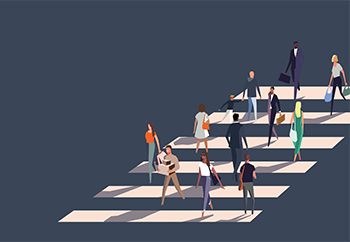 The vitality of the city: Data and patterns in the new era of downtownOctober 17, 2022
The vitality of the city: Data and patterns in the new era of downtownOctober 17, 2022 -
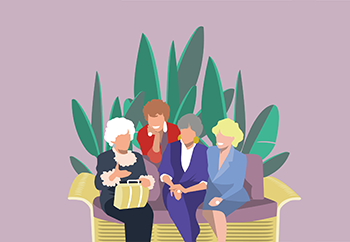 On golden years: The new frontier of aging in placeOctober 10, 2022
On golden years: The new frontier of aging in placeOctober 10, 2022 -
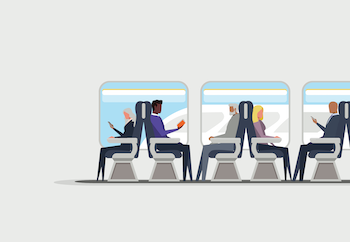 Move! Explore the changing world of transportationOctober 3, 2022
Move! Explore the changing world of transportationOctober 3, 2022 -
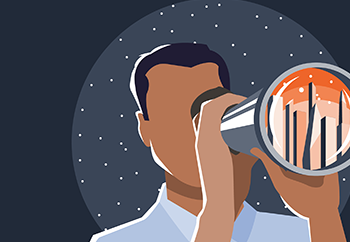 Lights in the darkness: Building a world where we can see the starsSeptember 12, 2022
Lights in the darkness: Building a world where we can see the starsSeptember 12, 2022




